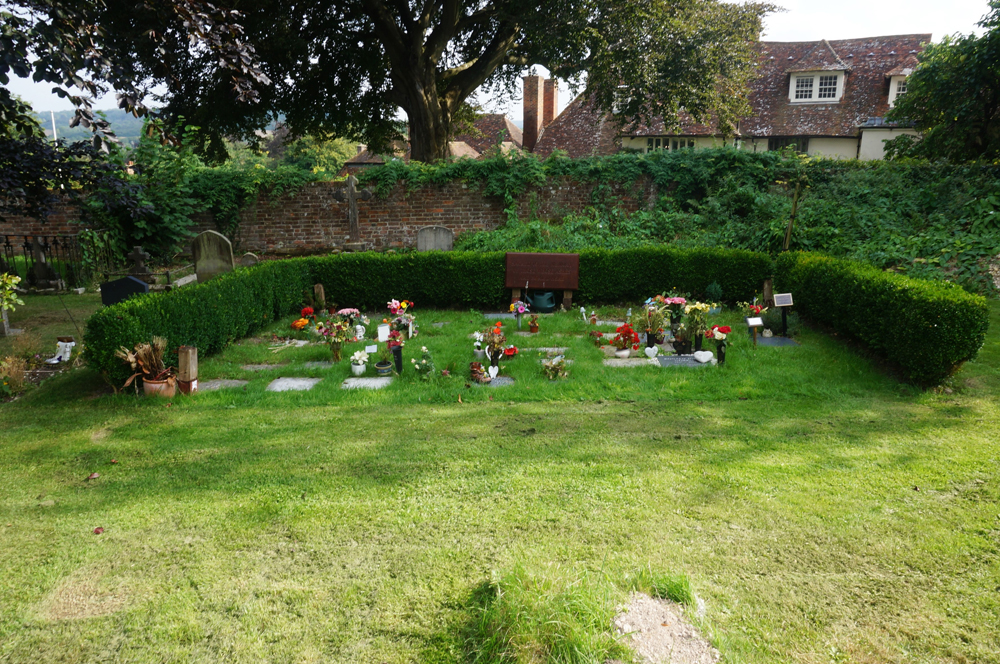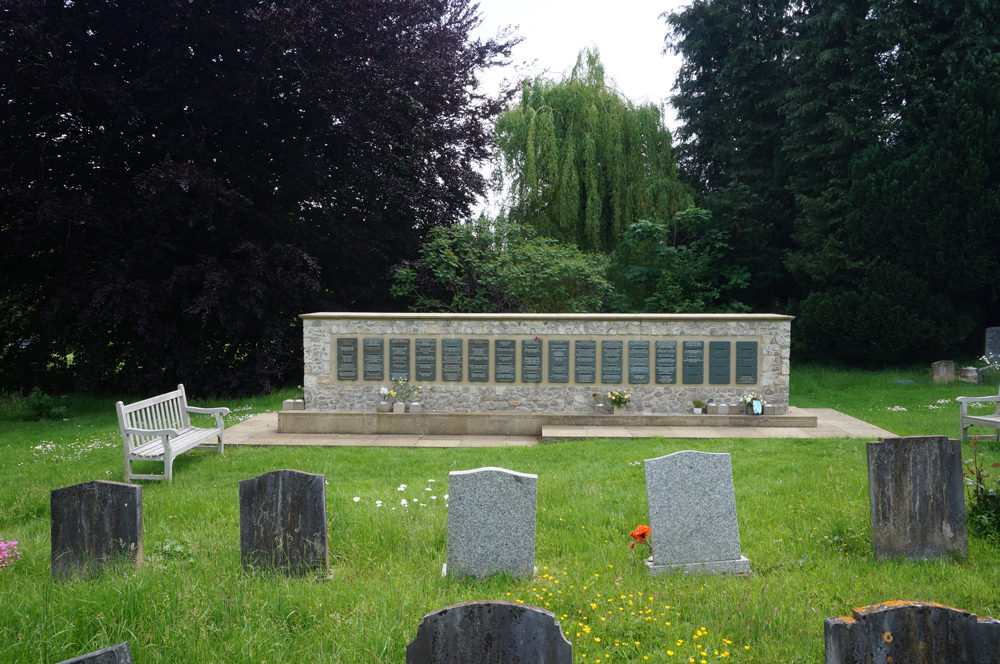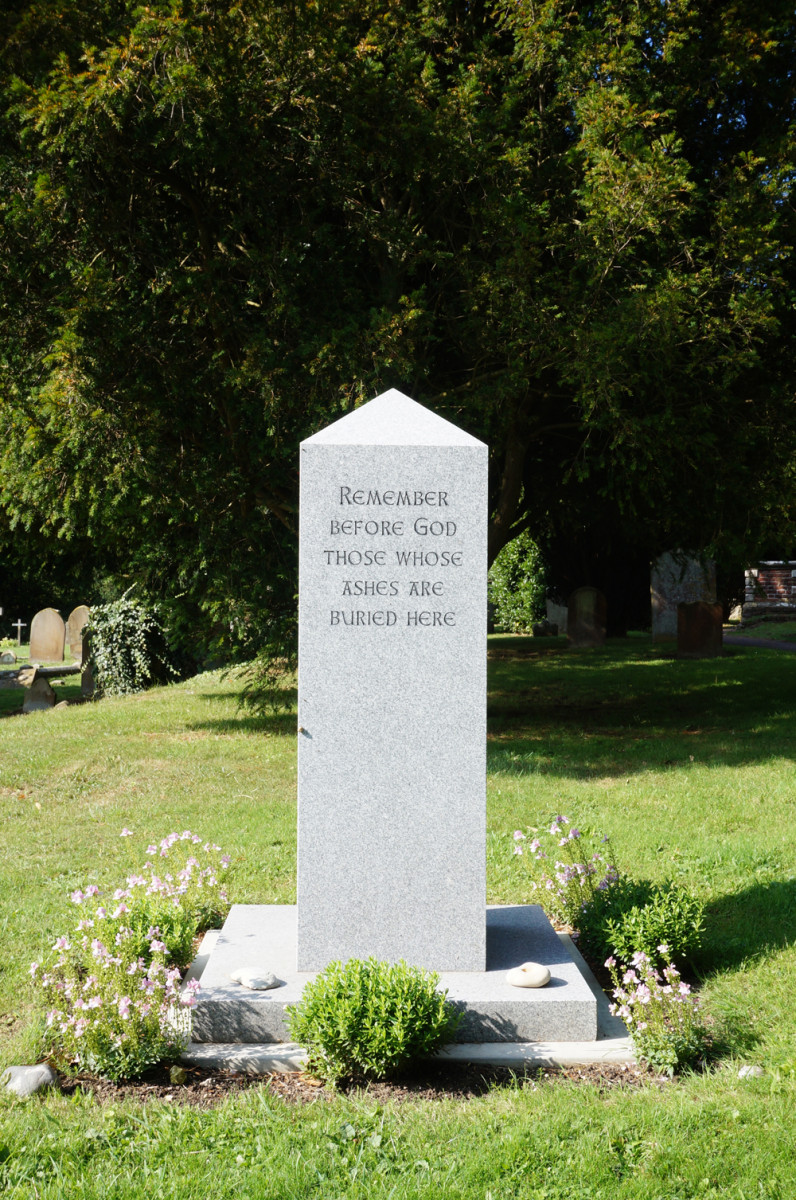Many parishes like to be able to offer in their churchyard the option of interment for cremated remains as well as for burials. This is usually done by setting aside a part of the churchyard as a Garden of Remembrance. If you’d like to do this, you and your PCC will first need to obtain the consent of your vicar. Before you start making any definite plans, you need to be clear about your reasons for doing it. What, primarily, do you want to achieve? A place of burial? A pleasant garden? A place for relatives and friends to come to pay their respects? A place for reflecting the Christian message of hope and eternal life? All of these?
At this Garden of Remembrance in a functioning churchyard, the area is denoted by a low hedge on three sides.
Everyone will have their own experience and views, which should be discussed with the incumbent. The burial of human remains is always a sensitive issue and it’s worth taking time over the planning. It’s important to consider how you commemorate interments. One way of doing this is to put up a central memorial or cross to all of them, with a Book of Remembrance inside the church, as well as a plan of the Garden to record whose remains have been interred where. Alternatively, each interment can be commemorated with a stone plaque in the ground or fixed to a wall. You’ll find below some questions to guide your discussions.
When you have started to form your ideas, contact the Care of Churches office to get the preliminary view of the Diocesan Advisory Committee (DAC) and to begin the process of applying for a faculty. A site visit can be arranged to offer you help and guidance. There is no single scheme which will be appropriate for all situations, so be open-minded and prepared to look at alternative suggestions when the DAC gets involved.

In this churchyard, which is also still used for burials, interments of ashes are commemorated by a wall with tablets fixed to it. A uniform style for the inscriptions has been maintained to ensure a harmonious effect. Note the ledge where potted and cut flowers are left by mourners, as well as the bench alongside for anyone who wishes to linger.
Location and design
Here are some questions to help you decide whether your proposed site is suitable and how to manage it.
- At the current rate of interments, how many years’ capacity will the Garden have?
- Is the site well away from trees? Their roots will make it difficult to dig holes for interments and they will shed leaves over the Garden in autumn.
- Will the Garden be easy to find for those attending interments and for subsequent visitors?
- Is there an existing path to the area? Does it provide level access for the elderly and disabled?
- If you need to lay a new path, where will it run and what materials will be used?
- How will the Garden be visually defined? Will you use planting or a different surface or a boundary wall? Will there be a central cross or memorial?
- Who will look after the Garden? What level of maintenance will be required to keep it looking tidy?
- If you decide to place a Book of Remembrance inside your church, will the building be kept open during the day so that mourners can view it?
- Will you permit plaques for individual interments? If so, what will the dimensions and preferred form of inscription be?
Practical matters
You may want to inform visitors about the purpose for which the area has been set aside. Here are some questions to consider about the notice that you install:
- What form will the notice take?
- What will be the most suitable position?
- What will be the most appropriate wording?

In this rural churchyard, the tablets commemorating individual interments over time are forming a continuous paved surface. In due course, the blank concrete slabs will be replaced with tablets bearing dedications to individuals.
Flowers
Visitors will often bring flowers and plants to commemorate loved ones. You will need to allow for this in a communal way, which does not become untidy or interfere with maintenance. This could be done by setting aside an area that is paved or laid to gravel on one side, or else a ledge around a central memorial. It’s good to encourage leaving fresh flowers as a symbol of the gift of creation and of the brevity of life. Some parishes also allow artificial flowers to be left from time to time. But either way, maintenance needs to include taking way dead flowers and decaying artificial flowers to keep the Garden tidy. Rose bushes and shrubs cannot be planted on individual plots.

Here is an example of a Garden of Remembrance where the interments are commemorated by a single memorial rather than individually.
FAQs
Does the land have to be consecrated?
Yes - a new area set aside for the burial of ashes does need to be consecrated. If the area is not consecrated, or you are uncertain of its status, you should contact the Care of Churches office to clarify the matter and arrange for consecration if required.
Do ashes have to be buried in caskets?
The Churchyard Regulations state that ashes may either be buried in a suitable perishable/biodegradable container or buried loose in an appropriately sized hole in the ground. Ashes must be covered with soil. They may not be scattered or strewn.
What are the practicalities of interring ashes from caskets?
It is important to allow sufficient depth for a burial in case room is needed for a further burial above. The top of the buried remains should be at least 300mm below ground level.
Do we need to keep a plan of burial of ashes?
Yes - as with full burials, ashes should be buried in plots according to a detailed accurate plan, which should be kept with other burial records. If ever a request is made for exhumation, this ensures that it can be properly carried out. Also, if further burials take place close to existing ones, buried ashes are less likely to be disturbed when their location is known.
Do we need planning permission to create a Garden of Remembrance?
You will need planning permission for a change of use if the churchyard is not already used for burials. That may well be the case if your church dates from the mid-19th century onwards, by which point interments were forbidden in some urban areas, or else if it’s dedicated rather than consecrated. You may also need planning permission for any structures that you plan to erect. Contact your local planning authority at an early stage to check.